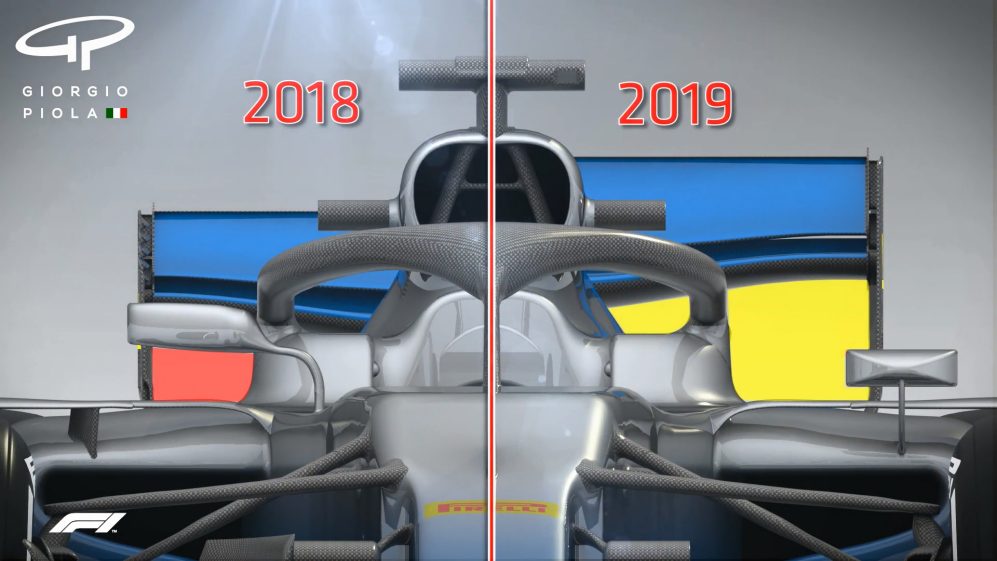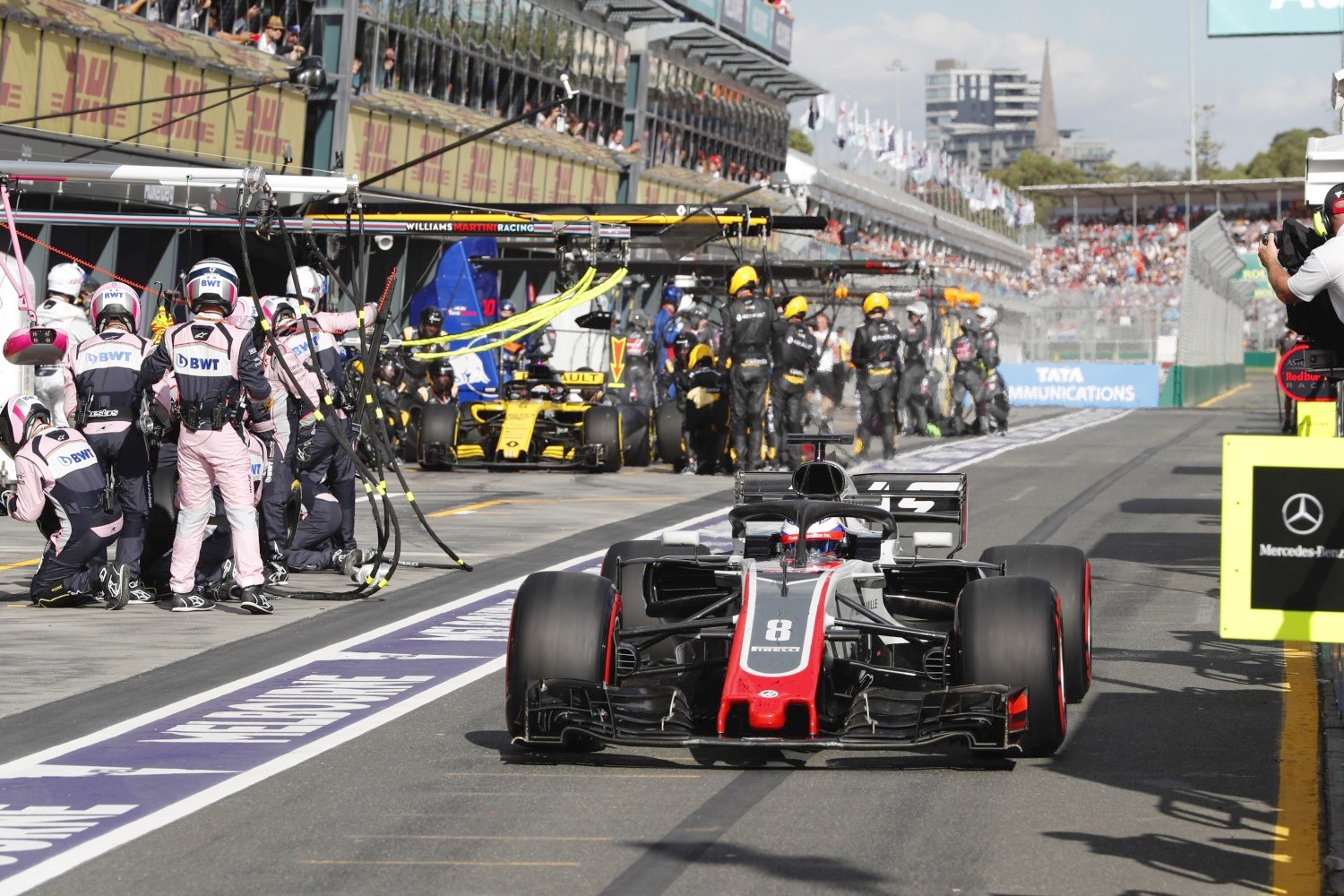Latest F1 news in brief – Friday
-

Grosjean in the pitlane in Melbourne driving last year's Haas Haas 'better and better' every year – Grosjean
- Vettel 'massively overrated' – Irvine
- Budget cap not close to agreement – Marko
- F1 RULES & REGULATIONS: What’s new for 2019?
Haas 'better and better' every year – Grosjean
(GMM) Haas is getting better at the formula one game.
That is the news from leading players at the small American team, including driver Romain Grosjean, and chief engineer Ayao Komatsu.
Komatsu says the biggest change in 2018, compared to Haas' first two years on the grid, was how the car was developed.
"It was the first year that we actually decided to develop the car throughout the season," he said.
Indeed, in 2016, Haas' rivals regularly criticized the team for running a car that was very similar to that of its technical partner, Ferrari.
The Ferrari deal has remained in place since then, but Komatsu says Haas was much more focused on improving its car in-season last year.
"We are very happy with our baseline and how the team is operating, especially considering that 2018 was only our third season," he said.
French driver Grosjean says 2019 will be another step forward for Haas.
"Yes, we are working hard on it," he told f1only.fr.
"Obviously, since we do not manufacture our own parts, it takes a bit longer for some parts than for other teams, but we are really close to our partners," Grosjean added.
"Honestly, it's getting better and better year after year, and it's really nice to see that things have clearly changed in the last three years."
Haas was fifth overall last year, but with the major aerodynamic rule changes for 2019, the team could struggle this season.
"I think we are dealing with it as well as we can," said Komatsu.
"It's not easy, I'm under no illusion. Going into our fourth season we need to look at ourselves, improving in every single department to have a chance of retaining fifth.
"So a huge challenge, but a challenge we will love to attack with our full capability."
Vettel 'massively overrated' – Irvine
 |
| Eddie 'The Mouth' Irvine, one of the worse drivers to ever race in F1 |
(GMM) Former Ferrari driver Eddie Irvine thinks Sebastian Vettel is "massively overrated".
German Vettel was criticized on all sides for his performance in 2018, having failed to win the world championship despite having a car widely regarded as a match for the Mercedes.
"I think Vettel is a good driver, but as a four times world champion, I just don't see it," Irvine, who was Michael Schumacher's teammate until 1999, told the BBC.
"I think he is massively overrated, he's a one-trick pony and Lewis has a much broader talent."
But 53-year-old Irvine, who made a fortune in his post-F1 days as a real estate developer, admits that he doesn't watch the sport anymore "because it bores me".
"It's just got safer and safer," he said. "Which is a good thing but it's gone too far. It's just progress, progress, progress until it's like 'What have we ended up with here?'.
"I think we have ended up with something a bit mushy and not that interesting."
And Irvine doubts that Liberty Media will do much to fix what he thinks is broken about F1, because the American company is most focused upon monetizing the sport.
"There are many things that need to change, and each thing that you change would have a knock-on effect. But the new owner has paid a lot of money for it so I don't think they are going to take the risks to do it," he said.
Budget cap not close to agreement – Marko
 |
| Dr Helmut Marko |
(GMM) Dr Helmut Marko has slammed the brakes on reports that F1 is now close to reaching an agreement about a 2021 budget cap.
In recent days, it was reported that at the January meeting of the strategy group, the big teams basically agreed with Liberty Media and the FIA about the imposition of maximum annual budgets of $185m (2021), $160m (2022) and $135m (2023).
But Red Bull's Marko told Auto Bild: "We are still a long way from an agreement.
"Basically, we agree with Ferrari and Mercedes in terms of numbers, but the other teams are still very critical.
"We also need to discuss which departments of the racing team fall under the budget limit. Nothing is clear," the Austrian insists.
Marko said there is also a lot of uncertainty about how the budget cap will be policed, especially at carmaker teams like Ferrari and Mercedes.
"Controlling it is very difficult to accomplish," he said. "How do you know which computer is working for the car company and which is working for formula one?"
F1 RULES & REGULATIONS: What’s new for 2019?
 |
| A higher rear wing for 2019 |
| Illustration by Giorgio Piola |
A new year means new rules. Those for 2019 may not be the wholescale changes due for 2021 – all aimed at making F1 racing even more competitive – but they are laying the all-important groundwork. Some will be obvious – the cars will look noticeably different – but others are subtler, though no less notable. Here’s our round-up of what you need to know about the new season’s regulations…
NEW FRONT WING
What’s the change: A wider, higher – and much simplified – front wing
Why has it been made: To help chasing drivers follow the car in front more closely – and in turn increase the possibility of overtaking.
The wing's width is increased by 200mm, its height by 20mm, and it’s moved forward by 25mm.
Complex endplates that outwash airflow around the front tires are banned. Instead, much simpler endplates mean almost the full width of the wing is devoted to direct downforce generation.
The wing’s added height further enhances its power and make it less sensitive to stall – so drivers are less likely to suddenly lose front-end grip when they close up on another car.
The multiple under-wing strakes seen on 2018 cars are now limited to two each side, meaning more of the airflow is fed to the underbody. This is less sensitive to aerodynamic disturbance and so creates a less choppy 'wake' for a following driver to deal with.
NEW BARGE BOARDS
What’s the change: Smaller – and repositioned – barge boards
Why has it been made: To make them less powerful and less aerodynamically disruptive. The barge boards are reduced in height by 150mm, and moved forward by 100mm to better join up the airflow from the front wing. This ultimately helps make the flow coming off the rear of the car less problematic for following drivers, meaning they should be able to get closer to the car in front.
NEW REAR WING
What’s the change: A higher, wider, simpler wing
Why has it been made: Like the front wing, to help promote even closer racing. Height is up by 20mm, taking the 'rooster tail' wake coming off the back car higher into the air. Combined with a width increase of 100mm, the larger wing assembly creates a bigger hole in the air – to the benefit of cars trying to slipstream behind.
Furthermore, the DRS opening is increased by 20mm, boosting its potential power by around 25 percent, and a limitation has been placed upon the pressure-equalizing endplate slots of 2018.
NEW BRAKE DUCTS
What’s the change: Simplified design
Why has it been made: To reduce the aerodynamic exploitation of brake ducts. Restrictions on complex designs mean less surface area for aerodynamicists to play with. The change also means less downforce reduction when that area of the car is in disturbed air – something else that, again, should help drivers when following another car closely.
2019: The technical regulation changes
REVISED Tire COLOURS
What’s the change: Rather than the rainbow of tire colors used in 2018, Pirelli have cut that down to three for 2019
Why has it been made: To make understanding strategy easier for fans, the terms hypersoft, ultrasoft and supersoft have been consigned to the history books. Now each Grand Prix will feature simply a white-marked hard tire, a yellow-marked medium, and a red-marked soft. However, the actual compounds used for those three designations will change depending on the circuit, with Pirelli having five to choose from – C1 being the hardest, C5 the softest.
BIOMETRIC GLOVES
What’s the change: Drivers are required to wear biometric gloves
Why has it been made: To increase safety and help facilitate medical rescue. The gloves – developed by the FIA Safety Department – feature sensors stitched into the fabric that monitor the driver’s pulse rate and the oxygen levels in his blood. They transmit that potentially life-saving data back to the at-track medical team, before, during and after a crash.
REAR WING ENDPLATE LIGHTS
 |
| Wing endplate lights |
What’s the change: Two additional rear lights, one on each endplate
Why has it been made: To increase visibility of cars in poor weather conditions, and hence improve safety. As well as the traditional rear central light, cars must also have an additional LED light on each rear wing endplate. These must be illuminated at all times when a driver is using intermediate or wet-weather tires.
INCREASED FUEL ALLOWANCE
What’s the change: Drivers may use up to 110kg of fuel – previously 105kg – in the race.
Why has it been made: To allow drivers to use the engine at full power at all times. They should no longer have to worry so much about conserving fuel – and will hence be able to push harder, especially in the closing stages of a Grand Prix.
EVEN STRONGER HELMETS
What’s the change: New, stricter crash helmet requirements
Why has it been made: To give F1 safety another leap forwards. As of 2019, all helmets must conform to the new FIA 8860-2018 standard. Over a decade in the making, this standard means an ultra-protective helmet offering a number of vital safety benefits, including advanced ballistic protection and increased energy absorption. The front of the visor has been lowered by 10mm to reduce the risks associated with impact from debris, while the helmet shell uses advanced composite materials to ensure improved resistance to crushing and penetration.
CAR AND DRIVER WEIGHT
What’s the change: Driver weight will now be considered separately to the car
Why has it been made: So that heavier drivers are no longer disadvantaged by the weight regulations. The minimum weight of the car, without fuel, has gone up slightly from 733kg to 740kg. More importantly, at least 80kg of that must be made up of the driver, his seat and driving equipment. Lighter drivers can bring themselves up to the 80kg threshold by adding ballast, but crucially this ballast must be positioned in the immediate cockpit area – and cannot be used elsewhere on the car to help improve its balance.
MISCELLANEOUS
Self-scrutineering: Cars will no longer be scrutineered in the traditional sense at the start of the Grand Prix weekend. Instead, competitors must sign a declaration that they are in compliance with the rules – and, of course, the stewards can make random checks at any time.
End-of-race signal: The traditional checkered flag is still shown as well, but the official end-of-race signal is now a checkered light panel at the finishing line.
Mirror mods: Small changes to the mirror regulations in light of the larger rear wing, in order to maintain adequate rear view visibility and safety.
Caught on camera: The on-board camera regulations have been modified to improve the TV spectacle.
Towing the line: Overtaking on race restarts is not allowed until a driver has crossed the finishing line – rather than the earlier safety car line as previously. Formula1
